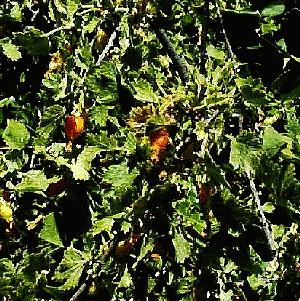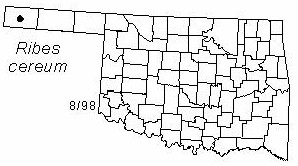
Shrub to 120 cm (4 ft) tall. Crown much branched. Twigs tan to red-brown, becoming gray, glandular pubescent, becoming glabrous; young twigs unarmed. Leaves alternate, crowded on the stem, simple, reniform to orbiculate, 0.9-3.8 cm (0.4-1.5 in) long and wide, 3-5 obtuse crenate lobes, glabrous above, glandular-pubescent beneath, light gray-green beneath; cuneate to subcordate at base; petioles may be equal in length to the blade. Flowers in drooping racemes or solitary flowers, glandular-pubescent bracts, cuneate to obovate; 1 flower, occasionally more, 0.6-0.8 cm (about 0.3 in) long; sepals 5, ovate, erect, petals 5, white, minute, orbicular and erect, united, usually hairy; stamens 5; ovary inferior. Flowers appear May to June. Fruit a berry, 6-8 mm (about 0.3 in) diameter, globose, bright red to yellow-red, waxy; seeds numerous, albuminous, matures July to August.
Distribution: Oklahoma, north to Montana and British Columbia, south to California and New Mexico. Rare in Oklahoma; restricted to northwestern Cimarron County.
Habitat: open rocky woodlands.
Comment: The genus name, Ribes, is derived from the Danish word "ribs" for the red currant; the species name, cereum, refers to the waxy fruit.
Wildlife benfits: the fruit is eaten by species of birds and other wildlife. Deer and cattle browse stems.
Horticulture: Occasionally cultivated. Can be propagated from seed and cuttings.
NWI status: none
Distribution on Oklahoma: 
BACK
NEXT
RETURN TO INDEX
Last update: 9/17/99
 Go to Oklahoma Biological Survey Home Page
Go to Oklahoma Biological Survey Home Page
 Disclaimer
Disclaimer